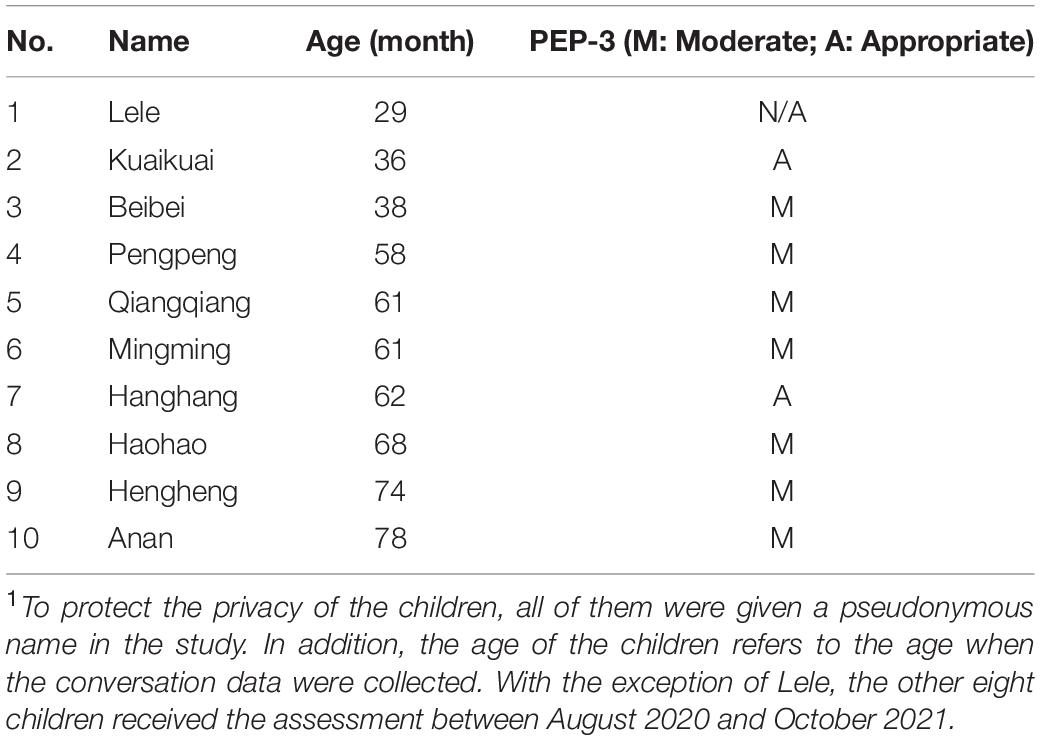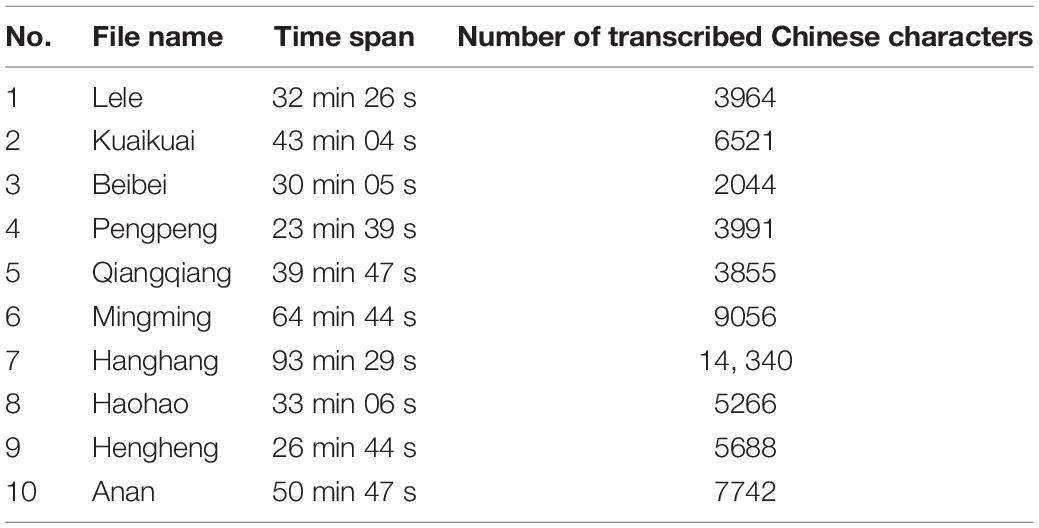- 1School of Foreign Languages, Jiangxi Agricultural University, Nanchang, China
- 2School of International Studies, Zhejiang University, Hangzhou, China
- 3Department of Rehabilitation, The Children’s Hospital, Zhejiang University School of Medicine, Hangzhou, China
Based on conversations between 10 Chinese children with Autism Spectrum Disorders (ASD) and five therapists in the context of Naturalistic Intervention, this study investigated the therapists’ agreement expressions in this typical setting. The study found that (1) the therapists mainly used four agreement strategies: acknowledgment, positive evaluation, repetition and blending. These four strategies could be used individually or in combination. The first three strategies and their combinations were used frequently during the therapeutic conversation. (2) With the major occurrences in the post-expansion position, the agreement expressions in the therapeutic conversation mainly performed three functions, namely, creating a supportive therapeutic relationship, serving as positive reinforcers and implementing interventions pertinent to communication skills. (3) This study proposed that the therapists’ preferred use of agreement expressions in the intervention process could be explained by the features of Naturalistic Intervention.
Introduction
Autism Spectrum Disorder (ASD) is a developmental disorder which is defined as “having difficulties in social communication, as well as restricted and repetitive behavior, interests or activities” (American Psychiatric Association, 2013, p. 50). While the existing estimates are variable, the prevalence rate of ASD is believed to be increasing over time (Elsabbagh et al., 2012). In the United States, the prevalence of ASD among children aged 8 years across 11 surveillance sites was 18.5 per 1,000 (1 in 54) in 2016, an increase of 9.5% compared with figures recorded in 2014 (Maenner et al., 2020). In mainland China, the prevalence of autism among children between the ages of 6 and 12 years in 2018 was estimated to be 7 per 1,000 (1 in 142) and the population of this group is as large as 700,000 to one million (Zhou et al., 2020).
To improve the life quality of this increasing population with a disability, early diagnosis and intervention are believed to be necessary and effective. During the process of intervention, the interpersonal interaction between the therapists or parents and the individuals with ASD is significant, as the intervention is implemented mainly through interaction. This significance is supported by previous studies on psychotherapy interaction, doctor-patient interaction and nurse-patient interaction (Lambert and Bergin, 1994; Karpiak and Benjamin, 2004; Wu, 2019, 2021; Demiris et al., 2020; Peoples et al., 2020; Taylor and Doolittle, 2020). These studies have revealed that common factors such as warmth, attention, empathy, affirmation and understanding play a positive role in client improvement. Due to the proven significance of therapeutic interaction, more qualitative and quantitative research efforts are needed to explore the forms, functions and the effectiveness of various interaction strategies employed by therapists when interacting with clients suffering from different disorders. For this reason, the study probed into one common yet under-investigated linguistic phenomenon in therapeutic conversations with Chinese children with ASD, that of the therapist’s use of agreement expressions.
As a common phenomenon in daily interaction, agreement has been defined as approval of a speaker’s opinions (Stenstrom, 1994) or as the willingness to accept the proposals and propositions of others (Eggins and Diana, 2005) or as a show of support by one speaker for the beliefs or propositions expressed by another (Johnson, 2006). Previous studies on verbal agreement in interaction have explored various aspects of agreement, including the strategies of expressing agreement, the sequential organization in which the expressions occur, the functions of agreement, and the factors influencing the selection of agreement or disagreement. Considering the research focus of the current study, we reviewed the research concerning the first three aspects.
In existing studies, the strategies of expressing agreement were classified as either form or content. As for forms, Heritage and Raymond (2005) examined four types of strategies through which a second speaker can index agreeing assessments with that of a first speaker: repeat/confirmation + agreement token; “oh”-prefacing; tag questions and negative interrogatives. In terms of content, Pomerantz (1984) classified agreement into “upgraded” (strong agreement), “same level” and “downgraded” (weak agreement). The “upgraded” expression is either a stronger evaluative term than the prior term or a term in which an intensifier is added to modify the prior evaluative term. As for the “same level” agreement expression, the previously used evaluative term may be repeated and may often include the word “too.” The “downgraded” expression refers to a weaker evaluative term than the previous term and could be followed by a disagreement expression. Bercelli et al. (2008) focused on clients’ strategies of response to therapists’ formulation and reinterpretation of their expressions and discussed two strategies of agreement: mere agreement and extended agreement. The former refers to the agreement tokens with no other elaborations, while the latter refers to the expressions in which the client provides an explanation by offering evidence in a narrative or non-narrative form.
Regarding the features of sequential organization of agreement, the most acclaimed research can be found in Pomerantz (1984). Focusing on the overall features of sequential organization of agreement in terms of expressing assessments, Pomerantz found that the agreement components were usually performed with a minimal gap between the turn taken by the first person in the conversation and the turn of the subsequent individual providing the agreement; the agreement was the preferred next action across most initial assessments. However, if the initial assessment was produced with self-deprecating sentences, the formulation of an agreement with prior self-deprecation was not usually preferred. In this case, the agreements could be achieved with weakly stated agreement components.
Various strategies of agreement perform different functions in conversation. For instance, through mere agreement and extended agreement (Bercelli et al., 2008), clients could show their understanding and agreement with therapists’ reinterpretations. Moreover, the client could display a change of perspective in relation to his/her own events or experiences and present this as if triggered by the therapists’ utterances. As for the four types of agreement discussed in Heritage and Raymond (2005), repeat/confirmation + agreement token and “oh”-prefacing conveyed the second speakers’ agreement as well as the epistemic independence or their assessment, while tag questions and negative interrogative strategies upgraded the agreement by conveying that the second speaker had a claimed epistemic right over the first speaker with regard to the issue. In Chinese conversation, the agreement expressions like “hao” and “dui,” served two functions: linking functions and positive response functions. In terms of linking functions, “hao” is often used as a marker of closure or transition indicating discourse boundaries, while “dui” marks the continuity of conversation. As for the positive response functions, “hao” is used to express acceptance of the other speaker’s act or utterance, whereas “dui” conveys acknowledgment of the propositional content of the utterance produced by other speakers (Wang et al., 2010).
Most of the studies on agreement were conducted using the conversation data of naturally occurring daily conversation (Pomerantz, 1984; LoCastro, 1986) or computer-mediated discussion (Baym, 1996); few studies analyzed the strategies and functions of agreement expressions produced by clients in therapeutic conversation (Bercelli et al., 2008). Much remains unknown as to the way in which therapists use agreement expressions as well as the functions agreement expressions perform in therapeutic conversation with ASD individuals. Moreover, most previous research on psychotherapeutic conversation with autistic individuals has explored either discursive issues, such as the construction of autism identity in conversation (Nadesan, 2005, 2008; Lester, 2014, etc.) or the conversational competence and impairment of autistic individuals (Damico and Nelson, 2005; Stiegler, 2007; Korkiakangas and Rae, 2014; Wiklund, 2016; Stickle et al., 2017; Wiklund and Laakso, 2020, etc.), while fewer studies have investigated the therapists’ conversational strategies, although it is believed that conversation or talk is “at the nucleus of psychotherapeutic practice” (Pamela, 2013, p. 4).
Proceeding from the existing research, the current study aimed to enhance the investigation of therapists’ behavior by addressing the following three research questions:
(1) What strategies did therapists adopt and how did they apply these strategies in expressing agreement in the therapeutic conversation with the Chinese autistic children?
(2) What were the sequential positions of agreement expressions in the therapeutic conversations?
(3) What intervention functions did agreement expressions perform in the conversations?
The Present Study
Collection of Conversation Data
The therapeutic conversations in this study were collected in the Department of Rehabilitation at the Children’s Hospital of Zhejiang University School of Medicine, from July to August 2021. Located in Hangzhou, this hospital is one of the National Clinical Research Centers for Child Health in China. Five therapists working in the center took part in the data collection. All of them had worked as therapists for children with ASD for a period of between 2 and 7 years.
In the center, the therapists use ABA therapy during interventions. As the widely accepted and evidence-based intervention method, ABA places more emphasis on therapists actively engaging with students as well as directing and prompting student behavior (Casey and Carter, 2016). Based on the rubric of ABA, psychologists and therapists have developed types of intervention techniques, such as Discrete Trial Training (DTT), Pivotal Response Treatment (PRT), Early Intensive Behavioral Interventions (EIBI) and Naturalistic Intervention (NI).
Free talk constituted the conversation data of this study, which were collected when the therapists were practicing NI. A distinctive feature of NI is the use of materials and toys that motivate the children to engage in the target behavior and promote the generalization of skills. Compared with DTT, NI offers low-structured activities which the children with ASD are able to select within a specific environment, thus creating more verbal interaction and a more spontaneous display of skills (Franzone, 2009). These skills include language skills, social skills such as learning to play games and cognitive skills. In this study, the activities adopted by the therapists during the intervention included telling stories, drawing pictures, playing games and free talk.
Ten male children with ASD, receiving therapy in the center, were recruited for the data collection, with a mean chronological age of 4 years and 8 months. The children had previously been diagnosed with ASD by the pediatricians in the center based on DSM-5 and the pediatrician’s clinical expert judgments.
To obtain information regarding each child’s strengths and needs, the children were asked to receive the Psychoeducational Profile Third Edition (PEP-3) assessment. PEP is regarded as an appropriate tool for planning individualized educational programs for children with ASD (Schopler et al., 1989). There are three composites and 10 subtests in PEP-3. The three composites are the Communication Composite, the Motor Composite and the Maladaptive Behavior Composite. The Communication Composite is a composite of the Cognitive Verbal/Preverbal, Expressive and Receptive Language subtests, the score of which indicates the development level of cognition and language (Schopler et al., 2005). In this study, seven of the 10 children were reported as having a moderate level in the Communication Composite, which indicates that their level of cognition and language development is between the severe and the mild level. Two of them were reported as having an adequate level in this Composite. The remaining child (Lele) did not take part in the PEP-3 assessment, as he was transferred to another rehabilitation center by his guardian in Sept. 2021, before the assessment being implemented. Table 1 presents the basic information of the children with ASD.
The data collection was facilitated by therapists using audio recordings. Before collection, the therapists obtained informed consent from the guardians of children with ASD. The length of the audio recordings used in this study amounted to 7 h and 17 min and the verbatim transcription of the audio recordings totaled up to 62,467 Chinese characters. Table 2 shows the time length of the audio files and their transcriptions.
Research Method
In this study, agreement is defined in a broader sense, i.e., as the speech acts by which the therapists demonstrate their acceptance of the linguistic expression, behavior, affect and attitude of children with ASD in relation to their prior conversation turns. Although agreement acts can be realized by verbal or non-verbal means or both simultaneously, this study focused on the therapists’ verbal expression of agreement.
This study adopted conversation analysis (CA) to describe the therapists’ agreement expressions. As a widely used method in the field of human interaction, CA has been extensively applied in research into psychotherapy since 1960, to provide a thorough description of how psychotherapists accomplish their tasks through talk (Pamela, 2013). To implement this research, we firstly recorded and transcribed the conversation data according to Jefferson’s transcription rules (Jefferson, 1984). In the transcribing process, firstly, we did a verbatim transcription1 of all the audio files, and then we provided the first transcription line for each Chinese character by using the Pinyin phonetic transcription system and marked the suprasegmental features in Pinyin. Below the first line of the Pinyin transcription, the verbatim translation of each Chinese word was presented and the third line was the literal translation. To ensure the quality of translation, we discussed with two native speakers of American English.
Pitch, intonation, pause, etc. in conversation were marked during the transcribing process, contextual information was also added in the transcription. These suprasegmental features and contextual information were taken into consideration when we judged whether the expression was indicating agreement or not. Based on the transcription, this study analyzed the phenomenon on two levels, that was the level of action in which the forms and the intervention functions of agreement expressions performed during NI, and the level of sequential organization in which the therapists’ agreement expressions occurred.
Therapists’ Strategies of Expressing Agreement
Based on the observation of the conversation data, this study identified that four strategies were used to express agreement during the therapeutic conversation between the therapists and the children with ASD. These four strategies are acknowledgment, positive evaluation, repetition and blending.
Acknowledgments
Bercelli et al. (2008) defined acknowledgment as responses displayed by an individual, demonstrating that they have heard and understood the previous conversation without agreeing or disagreeing with it. However, acknowledgment in this study is mainly defined as affirmation of the previous utterance.
In the therapeutic conversation of this study, the therapists often expressed their acknowledgment in relation to the children’s utterances. The acknowledgment markers used by the therapists included “dui, duile, hao, haode, en, shide,” etc.
Extract 1
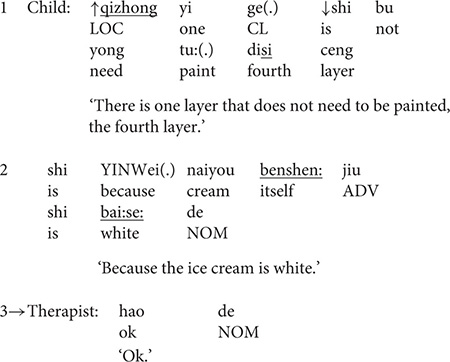
In Extract 1, the therapist and the child were drawing a picture of a drink together. When drawing the fourth layer of the drink, the child proposed to put an ice cream popsicle in it and suggested that this layer did not need to be painted, because both the ice cream popsicle and the paper were white. The therapist gave affirmation of the child’s answer. In this example, “haode” (ok) reflects the therapist’s positive feedback in relation to the child’s answer. In addition, this indicates that the child can either continue the conversation or start a new sequence (Wang et al., 2010).
Positive Evaluation
A positive evaluation expression is similar to the upgraded agreement (Pomerantz, 1984). The difference between these two terms is that Pomerantz’s “upgraded agreement” is relative to the assessment in the prior turn, while the therapist’s positive evaluation functions as a strong agreement with the child’s actions, as well as his/her verbal expressions.
In spoken Chinese, positive evaluation terms include “henhao” (good), “feichangbang” (very good), “henbang” (great), etc.
Extract 2
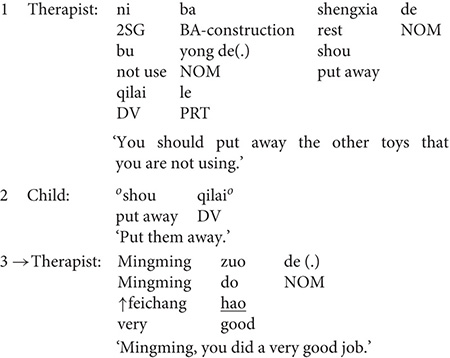
In Extract 2, after the therapist and the child finished the game, the therapist instructed the child to tidy up the toys. The child repeated the instructions given by the therapist and carried out the actions at the same time. Subsequently, the therapist praised the child’s behavior in an obvious sharper pitch. In this example, the evaluation conveys not only the therapist’s agreement, but also her positive assessment of the child’s behavior.
Repetition
Repetition is widely used in daily conversation. As Schegloff (1987, p. 70) stated, “not infrequently in naturally occurring, spontaneous conversation, speakers will repeat, re-say, recycle some part of their utterances.” Regarding function, Kim (2002) revealed that the next speaker’s repetition with downward intonation contour in American English performed interactive functions, such as providing confirmation or showing that the current speaker shared the opinion or agreed with the preceding speaker. In Chinese conversation, the speaker’s repetition indicated similar functions like listenership, alignment, agreement/confirmation, etc. (Huang, 2010).
In this study, we found that the therapists frequently repeated the child’s Second-Pair Part (SPP) to show their listenership, as well as their agreement with the child’s utterance. Following Kim (2002) description of next-turn repetition in American English conversation and Huang’s classification of other repetition in Mandarin child language (Huang, 2010), this study classified the therapists’ repetition into four sub-types: exact repetition, partial repetition, modified repetition and expanded repetition.
Exact repetition refers to “the reproduction of all the words of the model utterance in the same order, without any changes or additions” (Huang, 2010, p. 828), as shown in Extract 3.
Extract 3
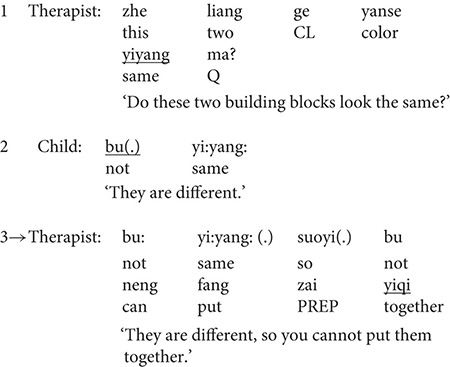
In this example, the therapist asked the child to build a series of blocks. After the child answered her question regarding the color of the block, the therapist indicated her agreement with the child by repeating the child’s answer exactly in a prolonged tone.
Partial repetition, also termed as reduced repetition, refers to an omission of morphemes or content words from the model utterance, as shown in Extract 4. In this example, the therapist and the child were talking about the scorching summer in Hangzhou city. The therapist partially repeated what the child said in the previous turn in an emphatic and prolonged tone.
Extract 4
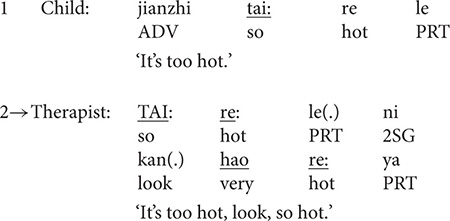
Partial repetition was used to perform not only an agreement function but also a repairing function. In CA, the term “repair” refers to “practices for dealing with problems or troubles in speaking, hearing, and understanding the talk in conversation” (Schegloff, 2000, p. 207). Addressing the problems produced by the children with ASD, the therapist would initiate and repair the problems by partially repeating the child’s utterance and correcting the mistakes in it.
Extract 5
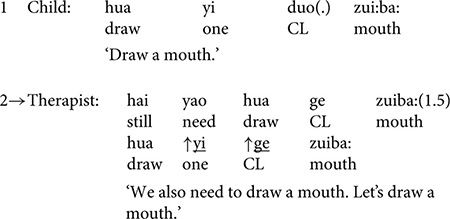
In Extract 5, the therapist suggested to the child that they drew a picture of a fish together. After drawing the tail, body and eyes of the fish, the child found that the picture of the fish still lacked a mouth, and he proposed to draw a mouth. The therapist agreed with the child’s plan and began to draw the mouth. In this extract, the child used the word “yiduo” for mouth, instead of “yige.” “Yiduo” is incorrect because in Chinese, “duo” is a classifier used to modify the word flower, while “ge” describes items such as person, clock, egg, etc. Addressing the problem, the therapist agreed with the child’s proposal by partially repeating what the child had said and simultaneously correcting the mistake by replacing “duo” with “ge” in a sharper pitch to attract the child’s attention.
Modified repetition refers to using part or all of an utterance as a model, while changing the pronoun, the order of the elements or the complement, etc. (Huang, 2010), as shown in Extract 6.
Extract 6
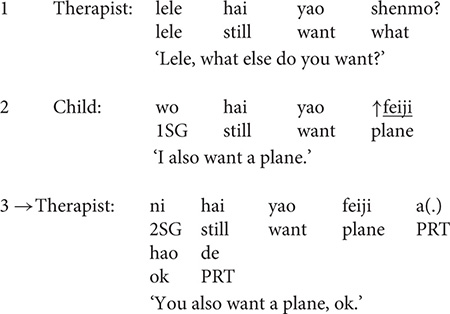
In Extract 6, the therapist and the child were playing with vehicle toys. After asking the child to choose a toy, the therapist expressed her agreement with the child’s immediate choice by repeating what the child said in a modified way, i.e., the therapist replaced “wo” (I) with “ni” (you) in the repetition expression.
In accordance with Huang (2010), expanded repetition in this study is defined as repetition including one element of the model utterance, and the other element created by the therapist without a preceding model. Due to the poor linguistic ability of children with ASD, they were sometimes unable to express themselves clearly and completely, therefore, when addressing this problem, the therapist added detailed information to the child’s utterance.
Extract 7
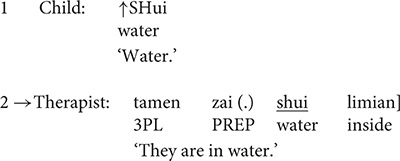
In Extract 7, the therapist and the child were drawing a picture of fish swimming. The therapist indicated that the fish had been drawn, then the child said “shui” (water), suggesting that the therapist should draw water because fish swim in the water. The therapist agreed and gave a complete statement by expanding upon the child’s utterance.
Blending
Blending refers to the strategy of combing the response turn in the SPP of the adjacency pair, produced by the child, along with part or the whole of the First-Pair Part (FPP) of the pair, produced by the therapist who initiated the request. By blending expressions, the therapist expressed her agreement with the child’s response and provided a more detailed and syntactically complete answer to the initiated question.
Extract 8
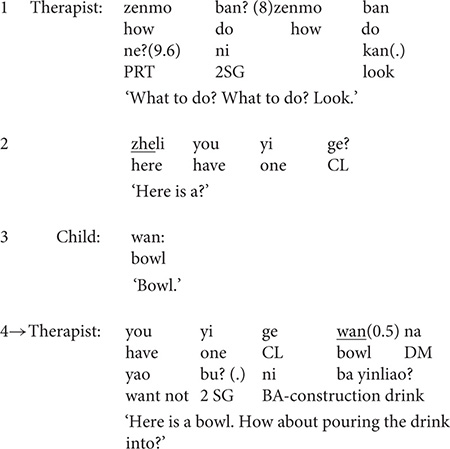
In this example, the therapist and the child were drawing the picture of a drink. After drawing the picture, the therapist and the child pretended to taste the drink. Since there was only one straw in the picture, the therapist guided the child to observe the bowl next to the drink in the picture. Under the therapist’s guidance, the child gave the correct answer, then the therapist gave a positive response to the child’s answer by blending part of his question with the child’s response.
Therapists’ Application of Strategies in Expressing Agreement
In accordance with the aforementioned four strategies, this study found that the therapists applied the strategies in two ways: expressing agreement using a single strategy and expressing agreement using multiple strategies.
Expressing Agreement Using a Single Strategy
In addition to Extracts 1, 2, 3, 4, 5, 7, and 8, the following extract is another example in which the therapist expressed agreement using a single strategy.
Extract 9
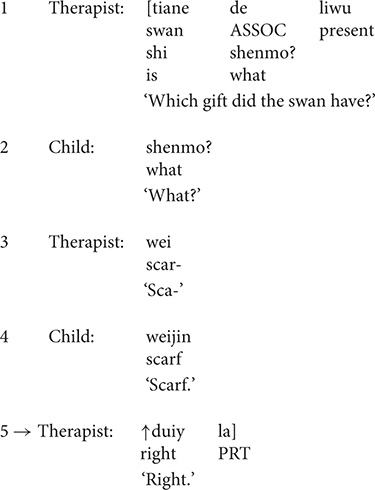
In this extract, the therapist and the child were reading a book about Christmas together. The therapist guided the child to observe which gift Santa Grandpa gave to the swan. Under the therapist’s guidance, the child gave the correct answer. The therapist thereupon affirmed the child’s answer using the strategy of acknowledgment in a sharper pitch.
Expressing Agreement by Multiple Strategies
In the conversation data of this study, there were two means of expressing agreement using multiple strategies: expressing by two strategies and expressing by three strategies.
Extract 10 is an example of expressing agreement by two strategies. In this extract, the therapist suggested to the child that they drew a picture of a drink together. After the therapist asked the child to tell the color of orange juice, the child answered uncertainly. In this situation, the therapist agreed with the child’s answer in a prolonged tone by using the strategies of partial repetition and acknowledgment simultaneously.
Extract 10
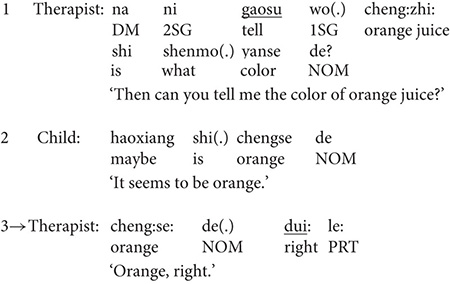
Extract 11 is another example of expressing agreement by two strategies. In this extract, the therapist and the child were playing a puzzle game that is, comprising a birthday cake with four layers of colors. After the child finished the first layer, the therapist asked the child to observe the color of the next layer. The therapist confirmed the child’s answer by stressing acknowledgment marker “dui le” (right) and a positive evaluation “hen bang” (very good).
Extract 11
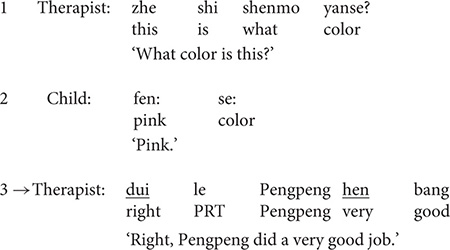
In addition to expressing agreement by two strategies, expressing by three strategies was also used frequently in the therapeutic conversation, as shown in Extract 12:
Extract 12
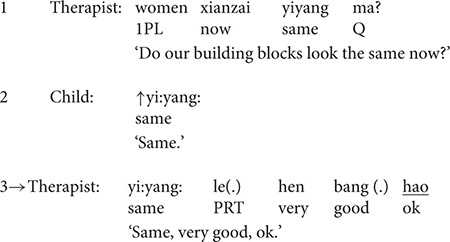
In this example, the therapist was playing the block-building game with the child. After the therapist finished the block-building, the child was asked to build the block in the same way. When the therapist asked the child whether their blocks looked the same, the child responded correctly. The therapist affirmed the child’s answer by using the strategies of exact repetition in a prolonged tone, positive evaluation and acknowledgment.
Sequential Positions of Agreement Expressions
Sequence organization in CA indicates how behaviors or discourse are continued or connected in a coherent, orderly and meaningful way (Schegloff, 2007). As the basic sequence in sequence organization, an adjacency pair refers to two or several turns that are related to one another in conversation. Generally, an adjacency pair consists of the FPP and the SPP; these two parts are produced by different speakers. However, such basic sequences are frequently expanded following the SPP. Two main sorts of post-expansions are identified: minimal and non-minimal. Minimal forms are produced by the speaker of the initiating action, which offer an adequate reaction to the SPP, but this reaction does not itself initiate a new sequence, while the non-minimal forms lead to new post-expansion sequences (Stivers, 2013).
In the conversation data of this study, a therapist’s agreement expressions occurred in either the basic two-part sequence or the post-expansions of the sequence. The majority of sequences with post-expansion were either question-answer sequences or request-response sequences. In the case of a two-part sequence, it was the child who initiated the topic by asking for certain items, then the therapist agreed with his/her initiated action. The child’s initiation of the conversation consisted of putting forward a proposal, asking a question, voicing their opinion or making a request, etc.
Extract 13
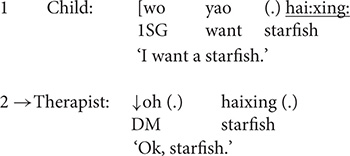
In this extract, the therapist and the child were playing with animal toys and fruit toys. When the therapist guided the child to distinguish between different kinds of fruit, the child’s attention shifted and he asked for a starfish in the toy box. The therapist did not refuse the child’s request. Instead, she made a positive response.
When the therapist initiated a sequence, the sequence always involved post-expansions in which the therapist’s agreement expressions occurred as a minimal form.
Extract 14
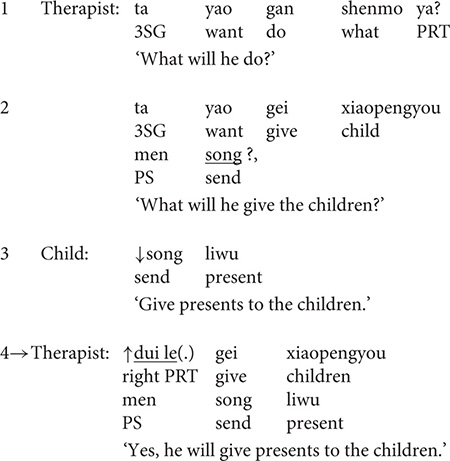
In this extract, the therapist asked the child to think about what Santa would give to the children. After the child responded to the question, the therapist firstly agreed with the child’s response in a sharper pitch and then repeated the response. In this case, the structure of the adjacency pair is as follows: the therapist’s request for information (FPP)→the child’s answer to the question as part of a sequence (SPP)→the therapist’s agreement with the child’s answer (Fpost). In this extract, the agreement expression is a minimal form of post-expansion produced by the therapist who initiated the act of requesting information. With this agreement expression, the therapist indicated that the child’s response to the requesting action was correct.
Distribution of Strategies in the Conversation Data
Based on the strategies and their sequential positions discussed in the previous sections, this study annotated the agreement expressions and explored the distribution of both single strategies and multiple strategies in the conversation.
Table 3 shows the distribution of single strategies in the conversation data. Among the four types of single strategies, the strategy of acknowledgment occurred with the highest frequency, while that of blending occurred with the lowest frequency. The further calculation, based on Table 3, showed that 75.65% of single strategies occurred in the post-expansion positions and only 24.35% of single strategies occurred in SPP positions.
Table 4 shows the distribution of multiple strategies in the conversation data. Among the seven types of multiple strategies in the conversation data, the multiple strategies of acknowledgment + repetition occurred with the highest frequency, and that of acknowledgment + positive evaluation ranked the second highest. What should be noted is that the three single strategies within these two multiple strategies appeared in the top 3 of Table 3. Moreover, Table 4 demonstrates that the dual strategies accounted for 91.24%, while the triple strategies accounted for only 8.76% in the data. Overall, an average of 80.37% of agreement expressions occurred in the post-expansion positions, while only 19.63% occurred in the SPP positions.
Tables 3, 4 show that: (1) the strategies of acknowledgment, repetition and positive evaluation were favored by the therapists in terms of expressing agreement. (2) Compared with triple strategies, dual strategies were apparently favored by the therapists when expressing agreement and (3) most of the agreement expressions occurred in the post-expansion positions rather than the SPP positions.
Functions of the Therapists’ Agreement Expressions
The fact that a high percentage of the agreement expressions occurred in the post-expansion position clearly indicated that the therapists had a preference for agreement during the therapeutic conversations. A careful observation of the conversation data showed that in the context of NI, the agreement expressions would help create a supportive therapeutic relationship, serve as a positive reinforcer and implement interventions pertinent to communication skills.
Creating a Supportive Therapeutic Relationship
The therapeutic relationship is the foundation upon which all therapeutic activities are constructed (Pamela, 2013). By expressing agreement with a child’s response, the therapists in this study displayed their roles as active listeners, encouragers and followers, thus creating a supportive therapeutic relationship with the children.
Acknowledgment markers such as “hao” (good) and “dui” (right), and positive evaluation expressions like “taibangle” (great) express not only the therapists’ agreement but also their active listenership and understanding, as well as their warmth and encouragement. This supportive relationship can be best demonstrated in cases when the children’s utterances contained incorrect expressions. In this situation, the therapists firstly showed their agreement with the expression and then corrected the mistake, instead of correcting the mistake directly, as shown in Extract 15:
Extract 15
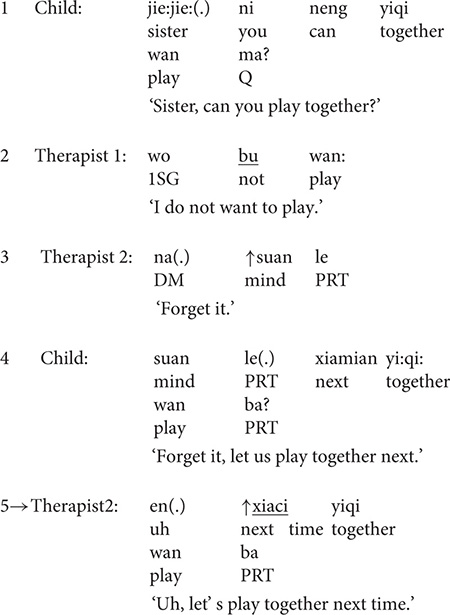
In this extract, the child wanted to play games with a pre-service therapist (T1) who was undergoing training in the center. This pre-service therapist refused the child’s invitation. The therapist (T2) seized this opportunity to help the child learn to accept the refusal. When the child made a slip of the tongue in expressing “Let’s play together next time.” by mistaking “xiaci” (next time) for “xiamian” (under), the therapist did not directly correct the mistake. Instead, she agreed with the child’s ideas at first and then corrected the mistake with a modified repetition.
As a follower, the therapist would deviate from the planned intervention schedules to accommodate the child’s choices. In this way, the therapist created a shared interaction, instead of the interaction being guided by the therapist alone, as shown in Extract 16:
Extract 16
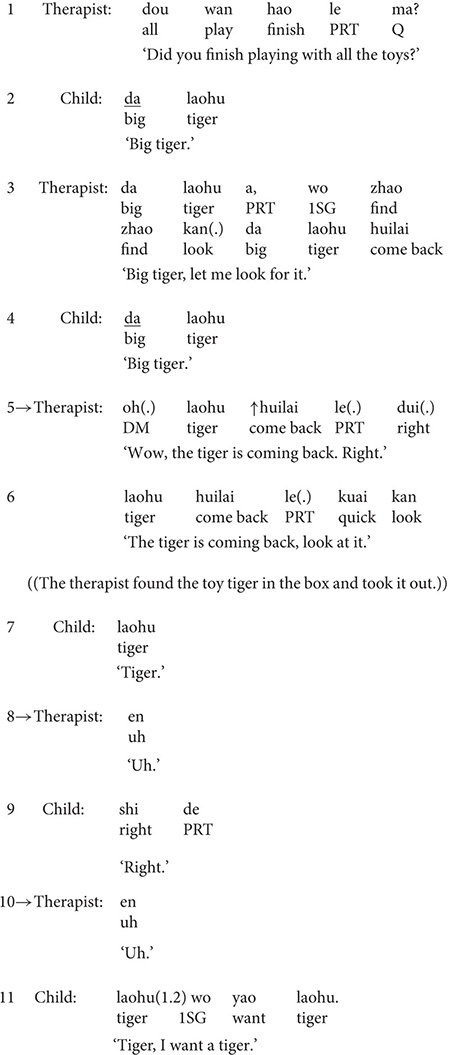
In this extract, the therapist and the child were playing with animal toys. The therapist intended to finish this game by asking, “Dou wan hao le ma?” (Have you finished your game?) in line 1, however, the child asked to continue the game by playing with a toy tiger. The therapist chose to show agreement with the child’s choice to continue the game by searching for the toy tiger in the toy box in line 6 and 7 and giving it to the child upon his request. By expressing her agreement, the therapist’s role as a follower provided the child with more opportunities to interact actively. For instance, she provided an opportunity for the child to perform the request act by saying “wo yao laohu” (I want a tiger.) in line 11.
Serving as Positive Reinforcers
As the most important and widely applied principle of behavior analysis, reinforcement or positive reinforcement occurs when a response is followed immediately by the presentation of a stimulus change, which increases the future occurrence of similar responses. In terms of formal properties, the stimuli of positive reinforcement include the edible reinforcer, the sensory reinforcer, the tangible reinforcer, the activity reinforcer and the social reinforcer. Among these reinforcers, tangible reinforcers refer to items such as stickers, trinkets, school materials, slips of paper, etc., while social reinforcers advocate physical contact, proximity, positive attention and praise, etc. (Cooper et al., 2019). The therapists’ agreement expressions functioned as social reinforcers in the intervention, as shown in the following extract:
Extract 17

In this extract, the therapist was guiding the child to learn vegetable classification. During the first attempt, the child failed to classify a carrot into the vegetable category. By saying “hao, wo zhidao le” (Ok, I got it.) in line 5, the therapist did not point out directly the mistake. Instead, she continued the intervention by asking the child to classify fruits and animals. After a while, the therapist asked the child to classify the carrot again; the child gave the correct response in this trial and the therapist confirmed the child’s response by saying “dui” (right) in line 12. After this correct trial, the therapist continued to consolidate the child’s knowledge of carrot classification by asking questions such as “huluobo shi?” (A carrot is?) five times, and the child answered correctly each time2. The successful trials in this example indicate the repeated intervention, as well as the function of agreement expressions as social reinforcers in NI.
Implementing Interventions Pertinent to Communication Skills
The strategies of expressing agreement, adopted by the therapist, not only conveyed their recognition of the children’s utterances but also implemented interventions to improve the children’s communication competence, including their language-production skills and social skills, etc.
Regarding language-production skills, the therapists in this study adopted the strategy of partial repetition and modified repetition, as well as blending, to help the children communicate in a correct, complete and detailed way, as shown in the following extract:
Extract 18
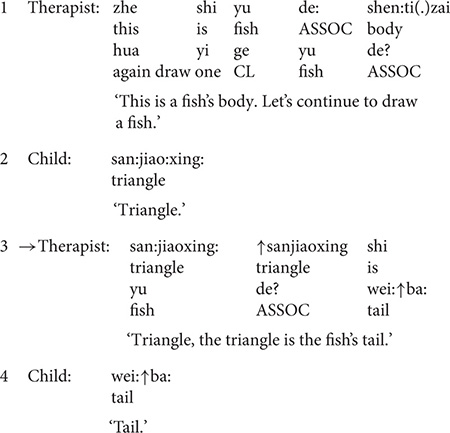
In Extract 18, the therapist and the child were drawing a fish together. After the child drew the body of the fish, the therapist asked the child what to draw next and the child answered “sanjiaoxing” (triangle). As a response to the child’s answer, the therapist began to draw the fish’s triangle tail. In this extract, the therapist conveyed her understanding and agreement with the child’s answer through exact repetition and expanded repetition in line 3. During the expanded repetition, the therapist added the information that the triangle he was drawing was the fish’s tail, thus making the expression “sanjiaoxing” (triangle) more understandable. In the following turn, the child understood the therapist’s intervention effort and he repeated the word “weiba” (tail) given by the therapist in the previous turn.
Apart from the agreement expressions in Extracts 18 and 19, the expression in Extract 5 expressed the therapist’s agreement while correcting language errors in the children’s utterances. In Extract 6, the therapist’s modified repetition provided a model of person shift in the conversation. In Extract 7, the therapist adopted the strategy of expanded repetition to produce complete and understandable expressions. On the whole, when using these agreement expressions, the therapists not only expressed their understanding of the children’s utterance but also provided a model utterance for the children to imitate.
In the conversation of this study, the therapist’s agreement expressions also played a positive role in improving the child’s social skills, as shown in the following extract:
Extract 19
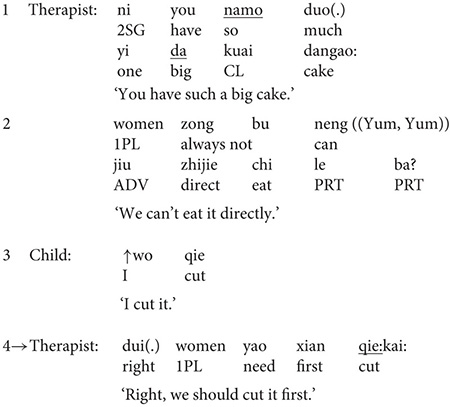
In this example, the therapist and the child were having a free talk. The topic of their conversation was a birthday party. In their talk, the therapist suggested that the birthday cake was a big piece and should not be enjoyed by the child alone. The child responded that he had to cut it into pieces, which was affirmed by the therapist; then the therapist guided the child to learn the social skill of sharing, using the strategy of modified repetition. By replacing “wo” (I) in the child’s turn with the inclusive first-person pronoun “women” (we), the therapist not only evoked a sense of commonality and a close tie between her and the child, but also explained to the child that sharing is a social routine.
Discussion
Based on the conversations between the therapists and the children with ASD in the context of NI, this study found that the therapists commonly used four strategies of expressing agreement in the post-expansion positions. The reasons for this finding, as this study proposed, were related to the intervention method of NI.
This proposal is enlightened by the study on eliding agreement in Ong et al. (2021). Ong et al. researched the eliding agreement (the absence of explicit agreement strategies) used by therapists among themselves when implementing Open Dialogue treatments with adults suffering from mental health problems. The discussion in the study shows that the frequent use of eliding agreements can be explained by institutional influences, including Stocks of Interactional Knowledge (SIK) on the way in which Open Dialogue should be implemented. For example, the Open Dialogue approach suggests therapists to understand clients’ utterances or behaviors from multiple perspectives. If therapists agree with one another’s views in the process, this will reduce the need to voice multiple perspectives. In addition, the strategy of eliding agreement rather than disagreement could avoid risking social solidarity between the therapists, which is in alignment with conceptual ideas, such as collaboration and equality promoted in Open Dialogue.
Based on the principles of Applied Behavior Analysis, NI occurs in the context of naturally occurring activities in order to increase generalization and spontaneity, as well as improve the maintenance of the target behavior. By incorporating child choice, various tasks, attempts at rewarding a child, and direct and natural reinforcers, this method creates a non-aversive environment to improve their acquisition of communication skills (Ashbaugh and Koegel, 2021). These features of NI can explain the therapists’ preference for agreement strategies in the conversation data of this study.
Firstly, as part of their SIK of implementing NI, the therapists often agreed with children’s choices during the intervention process, thus creating a supportive relationship with the children with ASD and providing them with more opportunities to communicate. Secondly, the therapists also used combinations of agreement strategies to implement the intervention. Compared with single strategies, expressing agreement by multiple strategies, as shown in Extracts 12–16, allowed the children with ASD to identify the expressions or behavior with which the therapists agreed, thus having an advantage over those providing general agreement (simple acknowledgment or positive evaluation) in reinforcing verbal skills. This advantage of reinforcing verbal skills was preliminarily measured in the quantitative results of a study, comparing the effects of general and descriptive praise when teaching intraverbal behavior to children with ASD (Polick et al., 2012). The results demonstrated the slight advantage of descriptive praise in terms of teaching efficiency. In addition, the advantage was echoed by the comments of one particular therapist in a discussion with the first author of this study:
“When we express our praise or agreement, we should make our expression specific. If you just tell the child ‘good’ or ‘OK’, the child may not know what “good” or “OK” means. As a result, it is not very likely that the child will continue to improve on this in the future. So, we must agree or praise in a specific way. If a child tidies up, we will praise the child by saying: ‘that’s so good. You tidy up so well’. Simply telling him, ‘You are great!’ is far from enough”.
The above discussion demonstrates the institutional influence of the intervention method on therapist talk, as highlighted by Ong et al. (2021). This influence also explains why the agreement expressions in the therapeutic context of this study are different from those in the non-institutional settings. Specifically speaking, previous studies on the agreement strategies in the non-institutional settings mainly investigated how the second speaker conveyed their agreement with the assessment made by the first speaker (Pomerantz, 1984; Heritage and Raymond, 2005). Within this particular context, the various types of agreement expressions denoted the second speaker’s approval and their cognitive stances toward the prior assessment as well as their epistemic rights to make an assessment. However, the agreement strategies used by the therapists in this intervention-oriented context primarily function as intervening facilitators. Moreover, due to different therapeutic contexts and identities of the speaker (client or therapist), the functions of agreement expressions in this study are unlike those discussed in Bercelli et al. (2008).
In general, the current study, together with the existing studies on agreement, demonstrates that context influences the practice of expressing agreement in interaction. For therapists, this kind of influence should constitute part of their SIK when implementing a particular method, in order to achieve better intervention outcomes. However, the existing literature on the therapeutic conversation with individuals with ASD shows that the studies in this field focused on the performance of the group, rather than how the therapists conducted their intervention through the “talk therapy.” Considering this status quo, the current study uncovered the agreement practice and its patterns of which therapists may be unaware. This may deepen therapists’ understanding of the agreement expressions in relation to their importance and effectiveness in therapeutic conversations, thus helping to improve the quality of intervention for children with ASD. Moreover, the strategies discussed in this study will provide a reference for future studies relating to expressing agreement during therapeutic interactions with children suffering from other disorders or diseases. Such future studies will illuminate how various therapeutic contexts shape the practice of expressing agreement in conversation.
Conclusion
This study has revealed how expressing agreement operates and contributes to autism intervention. The analysis found that the therapists employed four agreement strategies, namely, acknowledgment, positive evaluation, repetition and blending. These strategies were used either individually or in combination. The distribution of the strategies showed that most of the agreement expressions appeared in the post-expansion position of the sequence, and these expressions could help create a supportive therapeutic relationship, serve as positive reinforcers and implement interventions pertinent to communication skills. Moreover, this study discovered that the therapists’ preference for agreement expressions in the intervention process could be explained by the features of NI.
As for the limitations of this study, expressing agreement in therapeutic interaction is a multimodal act, which involves not only the verbal mode but also the non-verbal mode, such as nodding, gaze, gestures, smiling, etc. However, this study analyzed solely the verbal mode of expressing agreement. A multimodal study would certainly expand the semiotic landscape of the act of expressing agreement and offer more insights into the intervention practice of therapists. In addition, following the research design of Polick et al. (2012), the effectiveness of the agreement strategies can be compared in intervention sessions within a multiple-baseline design in future studies.
Data Availability Statement
The raw data supporting the conclusion of this article will be made available by the authors, without undue reservation.
Ethics Statement
The studies involving human participants were reviewed and approved by The Research Ethic Board of Children’s Hospital of Zhejiang University School of Medicine. Written informed consent to participate in this study was provided by the participants’ legal guardian/next of kin.
Author Contributions
XZ designed the study, analyzed the data, and wrote the manuscript. The corresponding authors BM and CL conceived this study, collected the data, and revised the manuscript. CL, LZ, and HL transcribed the conversation data, reviewed the literature, wrote sections of the manuscript, and revised the manuscript. All authors contributed to the article and approved the submitted version.
Funding
This research was supported by a grant from the National Office for Philosophy and Social Sciences, China (Title: A Contrastive Study of Multimodal Referring Strategies between Chinese High-functioning Autistic Children and their Typically-developing Peers 汉语自闭症儿童和正常儿童的多模态指称策略对比研究) (No. 17AYY009), a grant from the Provincial Office for Philosophy and Social Sciences of Jiangxi Province (Title: A contrastive study of multi-modal narration discourse between Chinese high-functional autistic children and their typical-development counterparts 汉语高功能自闭症儿童与正常儿童的多模态叙事语篇对比研究) (No. 20YY08), and a grant from Science and Technology Planning Program of Jiangxi Provincial Department of Education (Title: AI-aided Diagnosis of Chinese Children with ASD Based on Multimodal-discourse Corpus 汉语自闭症儿童多模态话语语料库构建及智能辅助诊断方法研究) (GJJ180213).
Conflict of Interest
The authors declare that the research was conducted in the absence of any commercial or financial relationships that could be construed as a potential conflict of interest.
Publisher’s Note
All claims expressed in this article are solely those of the authors and do not necessarily represent those of their affiliated organizations, or those of the publisher, the editors and the reviewers. Any product that may be evaluated in this article, or claim that may be made by its manufacturer, is not guaranteed or endorsed by the publisher.
Footnotes
- ^ The transcription symbols are listed in the Appendix.
- ^ Due to limited space, this study provided the transcription of the first three occasions.
References
American Psychiatric Association (2013). Diagnostic and Statistical Manual of Mental disorder (DSM-5§). Washington, DC: American Psychiatric Publishers. doi: 10.1176/appi.books.9780890425596
Ashbaugh, K., and Koegel, R. L. (2021). “Naturalistic interventions,” in Encyclopedia of Autism Spectrum Disorders, 2nd Edn, ed. F. R. Volkmar (New York, NY: Springer), 3078–3084. doi: 10.1007/978-3-319-91280-6_124
Baym, N. K. (1996). Agreements and disagreements in a computer-mediated group. Res. Lang. Soc. Interact. 29, 315–346. doi: 10.1207/s15327973rlsi2904_2
Bercelli, F., Rossano, F., and Viaro, M. (2008). “Clients’ responses to therapists’ re-interpretations,” in Conversation Analysis and Psychotherapy, eds A. Peräkylä, C. Antaki, S. Vehviläinen, and I. Leudar (Cambridge: Cambridge University Press), 43–61. doi: 10.1017/CBO9780511490002.004
Casey, L. B., and Carter, S. L. (2016). Applied Behavior Analysis in Early Childhood Education. New York, NY: Routledge. doi: 10.4324/9781315775371
Cooper, J. O., Heron, T. E., and Heward, W. L. (2019). Applied Behavior Analysis, 3rd Edn. Hoboken, NJ: Pearson.
Damico, J. S., and Nelson, R. L. (2005). Interpreting problematic behavior: systematic compensatory adaptations as emergent phenomena in autism. Clin. Linguist. Phon. 19, 405–417. doi: 10.1080/02699200400027163
Demiris, G., Ganz, F. D., Han, C. J., Pike, K., Oliver, D. P., and Washington, K. (2020). Design and preliminary testing of the caregiver-centered communication questionnaire (CCCQ). J. Palliat. Care 35, 154–160. doi: 10.1177/0825859719887239
Elsabbagh, M., Divan, G., Koh, Y. J., Kim, Y. S., Kauchali, S., Marcin, S., et al. (2012). Global prevalence of autism and other pervasive developmental disorders. Autism Res. 5, 160–179. doi: 10.1002/aur.239
Franzone, E. (2009). Naturalistic Intervention: Steps for Implementation. Madison, WI: The National Professional Development Center on Autism Spectrum Disorders.
Heritage, J., and Raymond, G. (2005). The terms of agreement: indexing epistemic authority and subordination in talk-in-interaction. Soc. Psychol. Q. 68, 15–38. doi: 10.1177/019027250506800103
Huang, C. (2010). Other-repetition in Mandarin child language: a discourse-pragmatic perspective. J. Pragmat. 42, 825–839. doi: 10.1016/j.pragma.2009.08.005
Jefferson, G. (1984). “On the organization of laughter in talk about troubles,” in Structures of Social Action: Studies in Conversation Analysis, eds J. M. Atkinson and J. Heritage (Cambridge: Cambridge University Press). doi: 10.1017/CBO9780511665868.021
Karpiak, C. P., and Benjamin, L. S. (2004). Therapist affirmation and the process and outcome of psychotherapy: two sequential analytic studies. J. Clin. Psychol. 60, 659–676. doi: 10.1002/jclp.10248
Kim, H. (2002). The form and function of next-turn repetition in English conversation. Lang. Res. 38, 51–81.
Korkiakangas, T., and Rae, J. (2014). The interactional use of eye-gaze in children with autism spectrum disorders. Interact. Stud. 15, 233–259. doi: 10.1075/is.15.2.12kor
Lambert, M. J., and Bergin, A. E. (1994). “The effectiveness of psychotherapy,” in Handbook of Psychotherapy and Behavior Change, 4th Edn, eds A. E. Bergin and S. L. Garfield (New York, NY: John Wiley & Sons), 143–189.
Lester, J. N. (2014). Negotiating abnormality/normality in therapy talk: a discursive psychology approach to the study of therapeutic interactions and children with autism. Qual. Psychol. 1, 178–193. doi: 10.1037/qup0000013
LoCastro, V. (1986). Yes, I agree with you, but agreement and disagreement in Japanese and American English. Jpn. Assoc. Coll. Eng. Teach. 18, 71–87.
Maenner, M. J., Shaw, K. A., Baio, J., Washington, A., Patrick, M., DiRienzo, M., et al. (2020). Prevalence of autism spectrum disorder among children aged 8 years–autism and developmental disabilities monitoring network, 11 Sites, United States, 2016. MMWR Surveill. Summ. 69, 1–12. doi: 10.15585/mmwr.ss6904a1
Nadesan, M. H. (2005). Constructing Autism: Unraveling the ‘Truth’ and Understanding the Social. New York, NY: Routledge.
Nadesan, M. (2008). “Constructing autism: a brief genealogy”, in Autism and Representation, ed. M. Osteen (New York, NY: Routledge), 78–96.
Ong, B., Barnes, S., and Buus, N. (2021). Developing multiple perspectives by eliding agreement: a conversation analysis of Open Dialogue reflections. Discourse Stud. 00, 1–18. doi: 10.1177/14614456211037439
Peoples, H. A., Boone, B., Blumenthal-Barby, J. S., and Bruce, C. R. (2020). How clinician-family interactions potentially impact clinicians’ conceptualization and discussions regarding prognostic uncertainties. J. Palliat. Care 35, 29–33. doi: 10.1177/0825859719845005
Polick, A. S., Carr, J. E., and Hanney, N. M. (2012). A comparison of general and descriptive praise in teaching intraverbal behavior to children with autism. J. Appl. Behav. Anal. 45, 593–599. doi: 10.1901/jaba.2012.45-593
Pomerantz, A. (1984). “Agreeing and disagreeing with assessments: some features of preferred/dispreferred turn shapes,” in Structures of Social Action: Studies in Conversation Analysis, eds J. M. Atkinson and J. Heritage (Cambridge: Cambridge University), 57–101.
Schegloff, E. (1987). “Recycled turn beginnings: a precise repair mechanism in conversation’s turn-taking organization,” in Talk and Social Organization, eds G. Button and J. R. E. Lee (Clevedon: Multilingual Matters), 70–85.
Schegloff, E. (2007). Sequence Organization in Interaction: A Primer in Conversation Analysis. New York, NY: Cambridge University Press.
Schopler, E., Lansing, M. D., Reichler, R. J., and Marcus, L. M. (2005). Examiner’s Manual of Psychoeducational Profile, 3rd Edn. Austin, TX: Pro-ed Incorporation.
Schopler, E., Reichler, R., Bashford, A., Lansing, M., and Marcus, L. (1989). Individualized Assessment and Treatment for Autistic and Developmentally Disabled Children: Psychoeducational Profile Revised (PEP-R). Austin, TX: Pro-Ed.
Stickle, T., Duck, W., and Maynard, D. W. (2017). “Children’s use of “I don’t know” during clinical evaluations for autism spectrum disorder: responses to emotion questions,” in A Practical Guide to Social Interaction Research in Autism Spectrum Disorders, eds M. O’Reilly, J. Lester, and T. Muskett (London: Palgrave Macmillan), 247–273. doi: 10.1057/978-1-137-59236-1_10
Stiegler, L. N. (2007). Discovering communicative competencies in a nonspeaking child with autism. Lang. Speech Hear. Serv. Sch. 38, 400–413. doi: 10.1044/0161-1461(2007/041)
Stivers, T. (2013). “Sequence organization,” in The Handbook of Conversation Analysis, eds J. Sidnell and T. Stivers (West Sussex: Wiley Blackwell), 726–740. doi: 10.1002/9781118325001.ch10
Taylor, E. P., and Doolittle, B. (2020). Caregiver decision-making for terminally ill children: a qualitative study. J. Palliat. Care 35, 161–166. doi: 10.1177/0825859719885947
Wang, Y.-F., Tsai, P.-H., Goodman, D., and Lin, M. Y. (2010). Agreement, acknowledgment, and alignment: the discourse-pragmatic functions of hao and dui in Taiwan Mandarin conversation. Discourse Stud. 12, 241–267. doi: 10.1177/1461445609346922
Wiklund, M. (2016). Interactional challenges in conversations with autistic preadolescents: the role of prosody and non-verbal communication in other-initiated repairs. J. Pragmat. 94, 76–97. doi: 10.1016/j.pragma.2016.01.008
Wiklund, M., and Laakso, M. (2020). Comparison of disfluent and ungrammatical speech of preadolescents with and without ASD. J. Autism Dev. Disord. 51, 2773–2789. doi: 10.1007/s10803-020-04747-2
Wu, Y. (2019). Empathy in psychotherapy: using conversation analysis to explore the therapists’ emphatic interaction with clients. South. Afr. Linguist. Apply Lang. Stud. 37, 232–246. doi: 10.2989/16073614.2019.1671881
Wu, Y. (2021). Empathy in nurse-patient interaction: a conversation analysis. BMC Nurs. 20:18. doi: 10.1186/s12912-021-00535-0
Zhou, H., Xu, X., Yan, W., Zou, X., Wu, L., and Luo, X. (2020). Prevalence of autism spectrum disorder in China: a nationwide multi-center population-based study among children aged 6 to 12 years. Neurosci. Bull. 36, 961–971. doi: 10.1007/s12264-020-00530-6
Appendix: Transcription Symbols
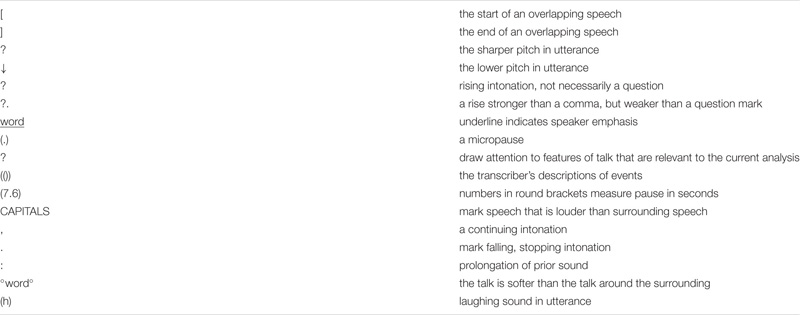
Keywords: agreement expression, therapist, sequential position, strategy, function, Chinese children with ASD
Citation: Zeng X, Ma B, Li C, Zhang L, Li C and Li H (2022) Therapists’ Expressions of Agreement in Therapeutic Conversations With Chinese Children With ASD: Strategies, Sequential Positions and Functions. Front. Psychol. 12:792167. doi: 10.3389/fpsyg.2021.792167
Received: 09 October 2021; Accepted: 15 December 2021;
Published: 10 January 2022.
Edited by:
Yijin Wu, Shandong University, ChinaReviewed by:
Yi (Esther) Su, Central South University, ChinaXueli Yao, Qingdao Agricultural University, China
Copyright © 2022 Zeng, Ma, Li, Zhang, Li and Li. This is an open-access article distributed under the terms of the Creative Commons Attribution License (CC BY). The use, distribution or reproduction in other forums is permitted, provided the original author(s) and the copyright owner(s) are credited and that the original publication in this journal is cited, in accordance with accepted academic practice. No use, distribution or reproduction is permitted which does not comply with these terms.
*Correspondence: Bosen Ma, bWFib3NlbkAxMjYuY29t; Chenxi Li, bGljaGVueGlAemp1LmVkdS5jbg==
 Xiaorong Zeng
Xiaorong Zeng Bosen Ma
Bosen Ma Chenxi Li
Chenxi Li Laiyun Zhang
Laiyun Zhang Chenxi Li
Chenxi Li Haifeng Li
Haifeng Li